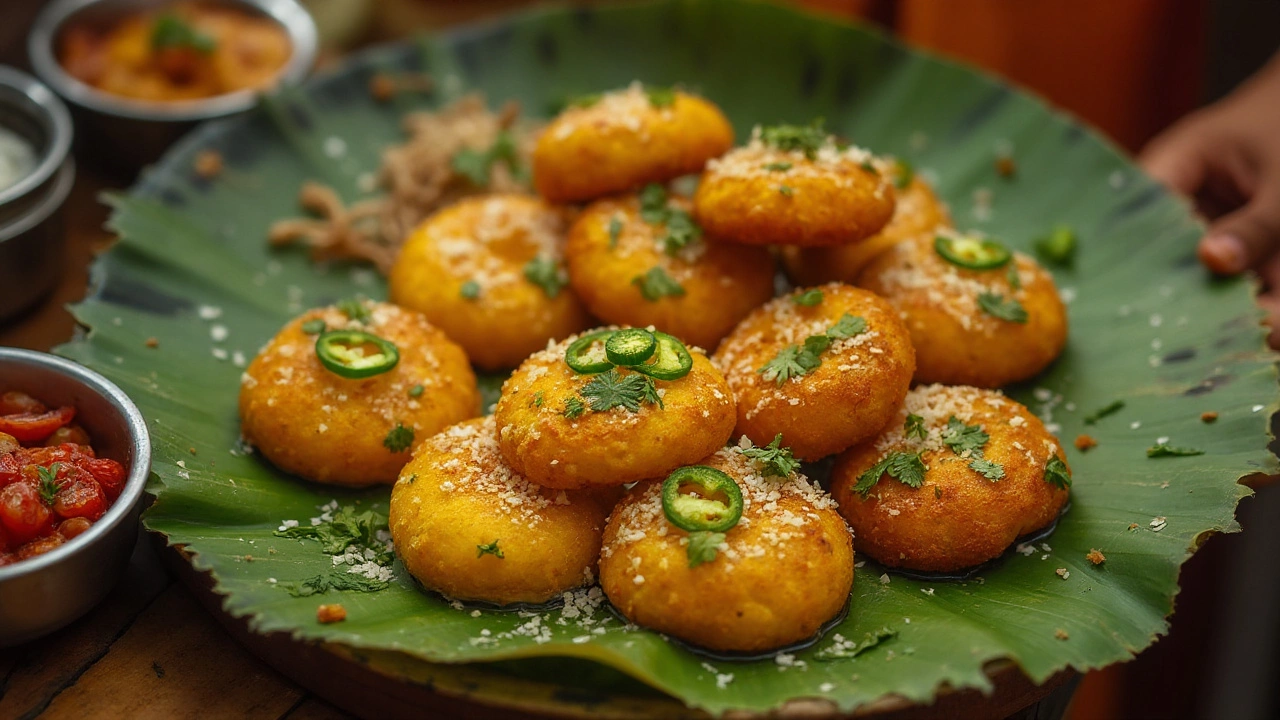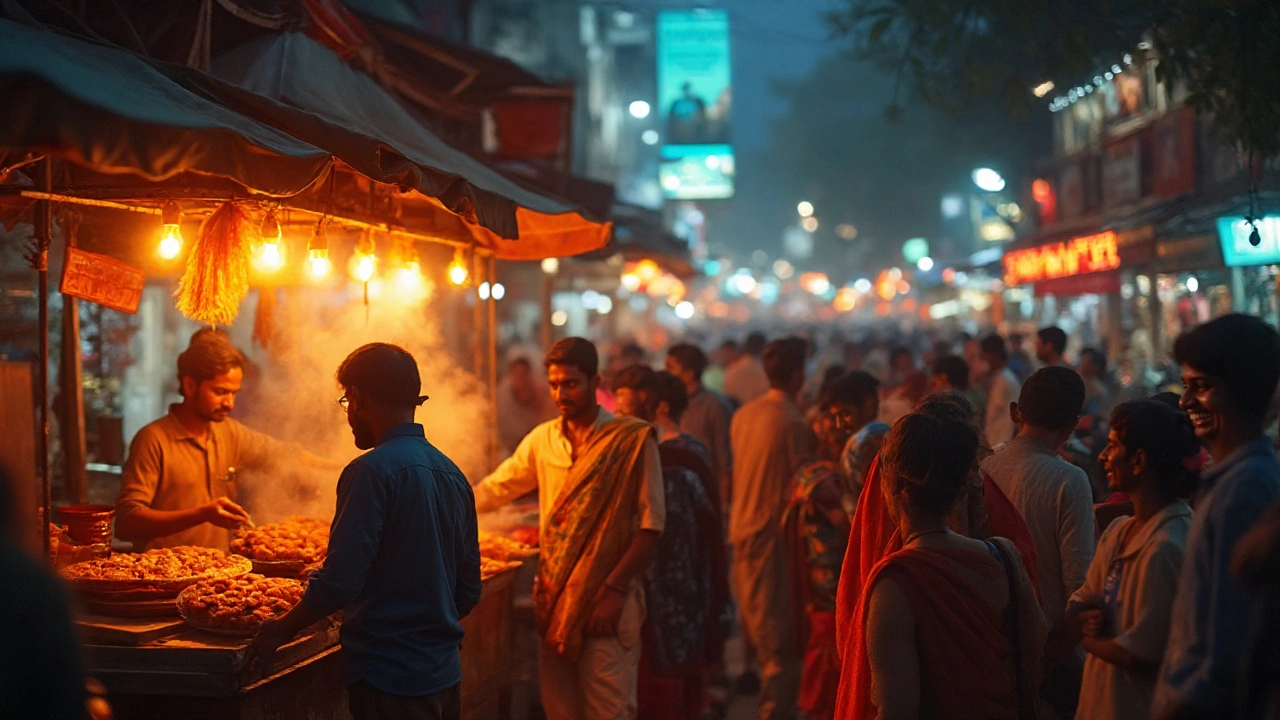The minute you land in any city in Gujarat, your senses get smacked awake. The air is thick with spices. People cluster near carts, plates in hand, hungry and loud. Lines snake around food stalls, arguments burst over the last serving, and everyone’s chasing that hit of tangy-sweet flavor you just can’t find anywhere else. Here’s the wild part: Street food isn’t just food in Gujarat. It’s a routine, a mood booster, and basically a social event. It’s like everyone got the memo that the best meals aren’t found in the fanciest restaurant but on the rickety push cart parked under a noisy banyan tree.
The Pulse of Gujarat’s Streets: What Makes the Food Obsession Real?
Gujarat’s street food scene is a moving celebration, running from sunrise to midnight snacks. Behind this culture is a climate that pushes folks outdoors and a historical love for sweet-savory combos. Most snacks are either deep-fried, steamed, or tossed in chutneys that make your tongue do somersaults. The quirkiest part: Gujarat has a pretty strict vegetarian streak. Even the biggest carnivores get tricked into loving every bite with zero meat in sight.
It’s not rare to see grandmothers arguing with teenagers about whether Dabeli tastes better in Bhuj or Kutch, or to meet business tycoons hunting the quietest chai stall. Street food is the real social glue—ties work friends together, fills kids’ after-school bellies, and somehow even calms mid-city traffic jams. Unlike anywhere else, street snacks sneak into breakfast, lunches, and post-dinner munchies. Most dishes are easy to eat on the move, which is perfect in fast-paced cities like Ahmedabad and Surat.
Hygiene? Sure, it’s a gamble, but things have changed lately. Street vendors have leveled up, rolling out gloves, filtered water, and charming stories about their secret spice blends. There’s even been a mini-revolution—with newer, cuter food trucks serving creative fusions, like Maggi topped with Dhokla (yep, that happened in Vadodara last year). Still, the originals rule the scene. Most vendors stick to family recipes going back four generations.
And the numbers don’t lie. A 2023 survey by Gujarat Tourism showed that for every 100 tourists, at least 80 made it a mission to eat at a street stall before heading to any formal restaurant. Looks like the reputation is here to stay.
The Iconic Classics: Dishes Every Gujju Swears By
Toss out the assumption that Gujarati food is bland or just “sweet.” Sure, there’s sugar, but street food here throws in everything: spice, sourness, crunch, softness—sometimes in one plate. Here’s a lineup of the core players you absolutely need to know:
- Dhokla: These bouncy, yellow steamed cakes never go out of style. Made with fermented rice and chickpea flour, Dhokla is airy, tangy, and best paired with green chili and tamarind chutney. Legend has it that an industrialist once ordered Dhokla for his private jet traveling from Rajkot to Dubai—it’s that addictive.
- Khandvi: It’s like an edible yellow ribbon: soft, spiced, and rolled. Khandvi is trickier to make than it looks, which is probably why you find grandmothers shaking their heads at impatient chefs at street stalls.
- Fafda & Jalebi: It sounds crazy—salty, crunchy chickpea sticks dunked with super-sweet syrupy spirals. Yet, no Sunday in Gujarat is complete without this duo, especially during festivals or cricket matches.
- Sev Usal: If you like thick, spicy curries, try Sev Usal from Vadodara. Chickpeas and peas in fiery gravy, buried under crispy sev (fried noodles), diced onions, and lemon juice.
- Dabeli: Born in Kutch, this is a spiced potato bun loaded with sweet and spicy chutneys, crunchy peanuts, and fresh pomegranate seeds. Each bite is an explosion of textures. Locals even rate entire food streets by how their Dabeli stacks up.
- Gathiya: Thicker than Fafda, yet somehow melt-in-the-mouth, Gathiya is *the* favorite for chai stops. Truck drivers swear it helps fight hunger on 7-hour highway hauls across the state.
- Locho: Originally an experiment in Surat gone ‘wrong,’ Locho is a steamed, soft, lumpy chickpea flour snack topped with sev, onions, and spicy oil. Locals bet you’ll end up loving it at first bite (and yes, it’s as fun as it sounds).
And it doesn’t end there. You’ll spot Bhajiya (spiced fritters), Pav Bhaji ( buttery veggie mash with bread ), Khakhra (crunchy wheat discs), and Samosas reinvented with things like cheese or dry fruits in street corners.
If you’re a number cruncher, food researcher Viraj Patel recorded more than 120,000 registered food carts operating across Gujarat by the start of 2025. Now, factor in the unregistered, and you’re looking at one cart for every 50 people in parts of Ahmedabad. If that’s not street food devotion, what is?
| Street Food | Key Ingredients | Typical City/District | Average Price (2025, INR) |
|---|---|---|---|
| Dhokla | Chickpea & Rice Flour, Yogurt | Ahmedabad | 20 |
| Khandvi | Gram Flour, Buttermilk | Rajkot | 30 |
| Fafda-Jalebi | Chickpea Flour, Sugar | Surat | 25 |
| Locho | Chana Flour, Spices, Oil | Surat | 35 |
| Dabeli | Pav Bread, Potato, Chutney | Kutch | 40 |

Secret Flavors & Insider Tips: How to Eat Like a Local
If you want to really nail the Gujarat street food adventure, timing is everything. Most locals know that the best Fafda-Jalebi lands on the cart around 7:30am, vanishing fast. Locho is the king of late mornings, making it the go-to at about 11am near every Surat railway station. Craving spicy Sev Usal? You’ll find the best stuff steaming up just after sundown in Vadodara’s maze-like street lanes.
Another key thing: Don’t judge by the looks. Some of the tastiest snacks are handed out from battered-looking carts with lines of rickshaw drivers fighting for the last serving. On the flip side, Vadodara has Insta-famous trucks with quirky themes and neon signs, but sometimes, the taste doesn’t beat old-school vendors nearby. Social media may guide you, but chat with locals or a rickshaw guy for the real scoop.
Let’s get real about spice. Gujarati snacks tend to balance heat by adding lemon, yogurt, or a mysterious sprinkle of sugar. Try everything the way locals do: one hand sorting green chilies, the other dunking Fafda in chutney. Wash it down with Masala Chai, or Chaas (spiced buttermilk) if you’re cooling off. Vendors stay happy if you’re patient and courteous. Most love talking about how they pick their ingredients or learnt the recipe from their great-granddad.
If you see “Jain” or “Swaminarayan” versions, those are snacks made without onion, garlic, or root veggies—watch for signs because preferences are a big deal in Gujarat. Most food is lactose-free or gluten-friendly by default, but always ask if you have serious allergies. And here’s a little-known truth: The fastest way to not look like a tourist is to stand, eat, and leave (no lingering selfies or lecture about your food blog).
Portions are small, but that’s so you can try half a dozen things without exploding. Street food is affordable, too, especially considering a meal can be less than the price of a cinema ticket. If you’re feeling extra brave, order snacks with “Double Chutney” or “Special Masala”—your taste buds will remember the trip forever.
Gujarat’s Street Food Through the Seasons and Festivals
The calendar completely reshapes what pops up on the street food menu. Every festival means some rare snack reappears, and the crowd multiplies. Navratri, the dance-fueled, all-night festival, needs late-night fuel. Out comes Handvo—crunchy pancakes packed with lentils and bottle gourd—or Surti Undhiyu, a slow-cooked winter veggie medley. During Makar Sankranti, kite flying is matched by steaming cups of sesame-poppy seed churma balls, sugarcane juice, and sweet hot corn roasted on charcoal.
Street food isn’t static. Every season, vendors come up with variations—think Mango Dhokla in summer or steamed corn chaat after festival bonfires. The festival effect is real. According to a 2024 Amdavad Municipal Corporation report, street food stalls see up to a 120% jump in business during Navratri. No wonder every second vendor gets their biggest sales around winter and spring festivals.
Tips for nabbing the best seasonal street bites? Look for queues. The longer the line, the fresher—and safer—the batch. If you spot a makeshift stall decorated with blinking LED lights or children singing film songs, chances are you’ve hit a festive jackpot. Definitely try Ponk—a delicacy of tender roasted millet, only available for a few weeks each year from November to January, especially in Surat. Don’t skip Bhungra Bateta in Rajkot; it’s spicy potato mashed and stuffed into hollow, crunchy corn sticks, a winter treat you’ll find no place else.
Some stalls run secret menus or “word of mouth” snacks, only serving to regulars or those who ask. So, try learning a bit of Gujarati (“Ek plate chhe, please”—meaning “One plate, please”). Most vendors will happily reward your effort with a little extra or a sample of their latest experiment.
Families in Gujarat even plan outings around street food, using WhatsApp groups to share which vendor is “trending” that week. Kids drag their parents for late-night Kulfi Falooda after Garba dances, and grandparents sneak out at dawn with their friends for fresh Fafda before the markets clog up. Food carts aren’t just about eating—they set the pace for the whole day, from sunrise snacks to midnight fixes after a wedding dance-off.
There’s truly nothing like walking down a busy street packed with color, music, and hands reaching for food you can only find in this part of the planet. Every city and even village puts its spin on the classics—so snack with an open mind and an empty stomach.
